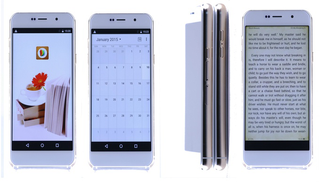About The Siam 7x, A Dark Horse Dual-Screen Smartphone From Out Of Nowhere
In an already-saturated smartphone market, there isn't much room for upstarts, but CRBT, Inc. believes its dual-screen Siam 7x smartphone can punch through. Although its Kickstarter campaign to fund the development of the Siam 7x fizzled somewhat (it was suspended and relaunched on Indiegogo after a minor copyright issue), the phone is apparently going to become a Real Thing.
After we wrote about the Kickstarter earlier this month, we had more questions than we had answers about this device (and the company making it), so we reached out and spoke with Darius Allen, CRBT's president.
Who?
Indeed, who is CRBT, Inc.? We had certainly never heard of the company before, and that's because (up to now), its primary business was caller ring back tone advertising (hence the CRBT name). The company has been around since 2004, and it has no previous experience developing hardware.
Therefore, the decision to wade into the thick smartphone market, especially at the higher-end, seems ludicrous.
This is not lost on Allen. However, the bottom line for him and his company is that they saw a gap in the smartphone market that they wanted to fill, and they felt they could do it. "There's more technology that's out there that [smartphone] manufacturers aren't releasing," he said. "Partially, that's because they're trying to sell you linear integrations of the technology and make profit along the way."
Two Screens
Specifically, they were intrigued by the dual-screen design that first gained prominence with the YotaPhone.
Indeed, the Siam 7x has a regular 5-inch (1280x720) display, but it also has a 4.7-inch E-Ink display on the back. CRBT, Inc. has built (and continues to update) custom software and firmware to enable additional features on that second screen.
Stay on the Cutting Edge
Join the experts who read Tom's Hardware for the inside track on enthusiast PC tech news — and have for over 25 years. We'll send breaking news and in-depth reviews of CPUs, GPUs, AI, maker hardware and more straight to your inbox.
"We have a lot of custom applications to make the second screen useful," Allen said. "There's no point in having just a plastic back. It's real estate, let's use it." He noted that, for example, an ereader application already works well on an E-Ink display, but they wanted to deliver more than that.
The Siam 7x uses the E-Ink display for news feeds, social feeds, notifications, calls and more. One use case Allen mentioned was if you're using your GPS and receive a call, the two screens allow you to answer the call and talk without having to minimize anything else.

How Will They Pull This Off?
It's one thing to astutely identify a void in a given market, but it's quite another to execute a plan to take advantage of it. Because CRBT, Inc. as a company has no hardware background, the first and most obvious question is how exactly the team plans to actually make the Siam 7x.
On this point, Allen is unbowed. He said that his U.S.-based engineering team includes seasoned veterans with CES design wins on their resumes, and they have already successfully designed and engineered working handsets that are ready to ship.
They've outsourced the actual manufacturing to a Chinese factory, but all the packaging and shipping is done back in-house at company headquarters in Fort Worth, TX. (Allen said that they looked at manufacturing in Houston but found the cost to be prohibitive.) And then, the company's software expertise can handle the tricky parts of making apps work on a second screen. Rounding out the package is CRBT, Inc.'s Blue Magic warranty.
Assuming the hardware and software are solid, there's still the issue of advertising and distribution. It sounds as if CRBT, Inc. is confident that the product will find some footing, mainly because the team feels that customers will want something more when they see it. Allen said that bigger companies can rely on customer loyalty to an extent to keep selling iterative handsets rather than being challenged to create innovative ones, and by pushing out new devices quickly, they can ensure sales via upgrades. The wager is that the Siam 7x will provide a compelling enough experience that customers with any amount of Samsung and HTC (et al) fatigue would consider switching.
Coming Soon: Two Full Color Displays
Although the second E-Ink display is a relatively new idea on its own, at first, CBRT, Inc. planned on something a little bolder. "Our original device that we've been working on for three years or so is two full color displays," said Allen.
He said they were trying to get away from the idea of the second display being black and white, because they wanted more functionality than the sort of "lite" uses that an E-Ink display affords. Two color displays sounds next to impossible. However, "My engineering team got it done," he said.
Allen said that the hangup came when his Chinese manufacturer struggled with the concept, and after much back-and-forth, the CRBT, Inc. team decided to just roll with a black and white second display for the launch of the first-gen Siam 7x, "Only to fill a void, to pick up the slack where YotaPhone couldn't deliver" in the North American market.
Now, though, Allen is confident that a dual, front-and-back color display smartphone is in the offing. "On our flagship device that we're going to launch next year, the back screen is going to be fully functional, as is the front screen."
The Specs
The Siam 7x runs on a quad-core MediaTek MT6735 SoC, which has an ARM Mali T720 GPU.
The bill for the Siam 7x will be $549, which is by no means at the top of the smartphone cost heap, but it is significantly higher than many "flagship" killers. With that price tag, though, you do get a pair of SMS Audio Biosport ear buds, which normally cost $149.95 on their own. With that in mind, what is effectively $400 for the smartphone itself is a much more palatable cost. For now at least, the pricey earbuds and Siam 7x are a package deal.
(You can, however, still snag one for $420 via the Indiegogo campaign for a few more days.)
| Siam 7x | |
|---|---|
| Display | -Front: 5-inch IPS (1280x720)-Rear: 4.7-inch E-Ink paper touch (16 gray level adjustment, 235 ppi, 960x540) |
| SoC | MediaTek MT6735 (quad-core ARM Cortex-A53 64-bit, 1.3 GHz) |
| GPU | ARM Mali T720 |
| OS | Android 5.0 Lollipop |
| Dual SIM | -Micro SIM-Nano SIM/TF card 2 in 1 |
| Cameras | -Rear: 16MP autofocus w/LED flash, shoots in 1080p HD-Front: 8MP |
| Sensors | Gravity, proximity, light, magnetic, gyroscope |
| Network/Bands | -2G: GSM 850/900/1800/1900 MHz-3G: WCDMA 850/1900/2100 MHz TD-SCDMA-4G: FDD-LTE Cat.4 150 Mbps (Band 1/3/7/20), TD-LTE 2, 4, 7, 17 |
| Connectivity | -802.11 a/b/g/n/ac Wi-Fi, supports hotspot-GPS, A-GPS-Bluetooth 4.0, IR remote, FM radio-3.5 mm earphone jack-micro USB |
| Battery | 2100 mAh |
| Dimensions | 142 x 70.6 x 8.9 mm, 170g |
| Warranty | Blue Magic |
| Price | $549, with earbuds |
The 2100 mAh battery looks like it could be a trouble spot for a phone with two displays, but Allen said, "Our team did a great job of engineering to utilize less energy on normal operations." He also pointed out that because the E-Ink display can handle a number of applications, you can use the lower-power display often, which has the net result of consuming less juice.
This is a GSM phone and thus will operate on AT&T and T-Mobile networks. Allen said the company is working on carrier partnerships, including potentially a CDMA version of the Siam 7x for Verizon and Sprint networks.
Challenges Accepted
CRBT, Inc. has a huge challenge ahead of it, and one can't help but wonder if the company is in for a rude awakening when the Siam 7x slams into the wall of a North American smartphone market that is well-saturated by a flood of quality handsets, most of which come from a small group of heavy-hitters. One does not simply walk into the smartphone market, to borrow the meme.
On the other hand, if the company can put together a strong one-two punch of hardware and software to go with its more or less exclusive dual-screen design, it may just be able to sway smartphone customers who have become less than enthusiastic about the offerings from the established smartphone makers.
______________________________________________________________________

Seth Colaner is the News Director at Tom's Hardware. He curates and edits the news channel and also writes on a variety of topics. He would have become a professional ultimate Frisbee player, but he was born 15 years too early.
Follow him on Twitter @SethColaner. Follow us on Facebook, Google+, RSS, Twitter and YouTube.
-
Gaidax Way too expensive for what is effectively a gimmick.Reply
If the specs were at least decent it could be okay, but really 720p main display and terrible low end CPU? It's fine for $150 phone not for $400-500 one.
At the very least should have given in full HD main screen, really.
I hope at least base storage is decent, if it's 16GB then it's a joke.
You can have a kickass ASUS phone for like $300 with 64GB storage, 4GB RAM, good display and powerful CPU. And there is a whole torrent of kickass flagship killers much cheaper than this phone, I just have no idea how they intend to sell this thing for $550 - drop the earbuds and drop the price to $250 and you can have some deals, but I guess that would be selling at loss after 3 years of development. -
CaedenV What ever happened to color Mirasol displays on phones? I get that it would be a nitch market as it would not do video/animation very well, and would likely lack a back-light... but it would be so cool to have a static color display on a phone that takes next to 0 power. Would be great for people who spend lots of time outdoors, or who want a phone with all week battery life!Reply
Also, isn't there a color e-ink display available for manufacturers too? Kinda surprised we do not see that out in the wild yet either. -
zodiacfml Doesn't help or fix anything, little value. Only valuable thing is for ebook readers not to bring another device with them. Yet, reading on a such a non-tablet screen might be on the small side.Reply -
hannibal This could provide superior usage time, when using the e-inc side of the phone, and the normal side is used when the speed is essential. So this could be the most useful phone, for those who need very long operation time, between charging the phone.Reply
So for example if you go trekking to the wilderness for two weeks and still want to have smart phone with you, this may be the solution, because e-inc really use less power than normal LCD. -
alidan ReplyThis could provide superior usage time, when using the e-inc side of the phone, and the normal side is used when the speed is essential. So this could be the most useful phone, for those who need very long operation time, between charging the phone.
So for example if you go trekking to the wilderness for two weeks and still want to have smart phone with you, this may be the solution, because e-inc really use less power than normal LCD.
it effectively doesn't even need to power the screen at all, outside of refresh. -
10basetom I would wait for the Siswoo R9 Darkmoon and Umi Zero 2 to come out and get reviewed before investing in this project.Reply
Most Popular


